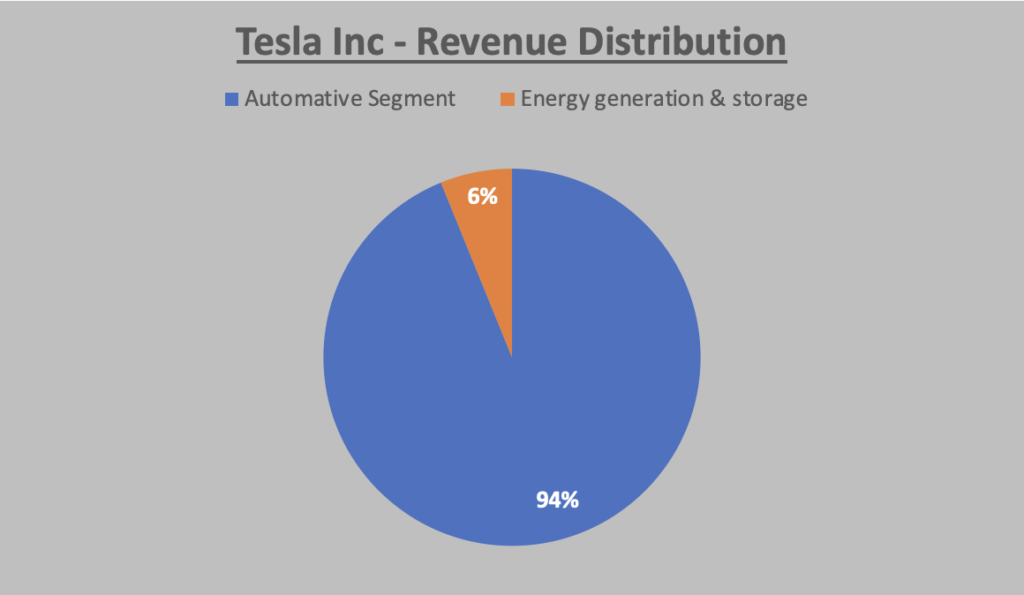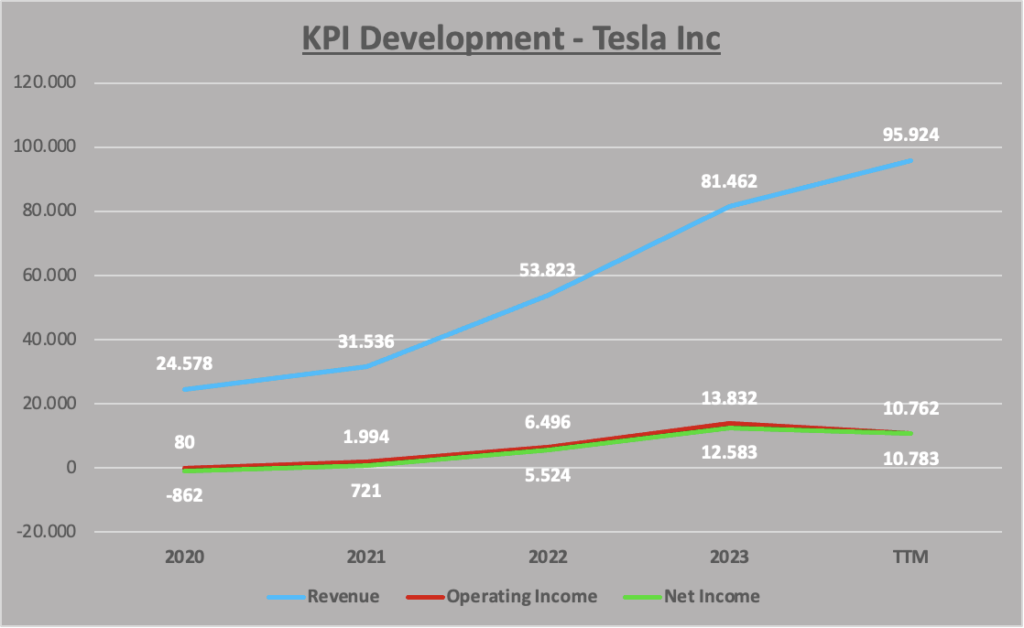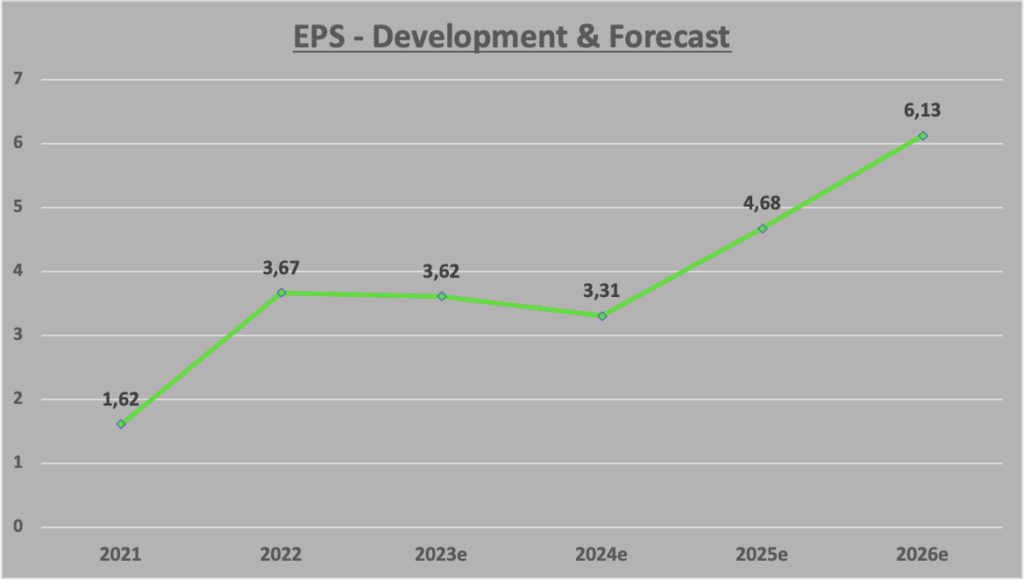In this stock analysis we will learn everything about the Tesla stock. We will analyze Tesla’s profitability, financial security & growth and in the end we will evaluate the share price. You can then decide whether Tesla is a suitable investment for you or not.
Company profile
Tesla Inc., a renowned American multinational corporation, has emerged as a pioneer in sustainable transportation and energy solutions. Founded in 2003 by Martin Eberhard and Marc Tarpenning, Tesla’s mission is to accelerate the world’s transition to sustainable energy through its innovative products and services.
At the Forefront of Electric Vehicles
Tesla’s core business lies in designing, manufacturing, and selling electric vehicles (EVs) that deliver exceptional performance, efficiency, and style. The company’s lineup of EVs includes the Model 3, Model S, Model X, Model Y, Cybertruck, and Tesla Semi. These vehicles have garnered widespread acclaim for their cutting-edge technology, advanced features, and impressive range capabilities.
Expanding into Energy Generation and Storage
Recognizing the need for sustainable energy solutions, Tesla has expanded its portfolio to encompass solar energy and battery storage systems. The company’s solar panels and solar roofs provide clean, renewable energy to homes and businesses, while its Powerwall and Megapack batteries store excess energy for on-site use or grid integration.
Vertical Integration for Enhanced Efficiency
Unlike traditional automakers, Tesla operates with a vertically integrated approach, controlling various aspects of its production process, from battery manufacturing to vehicle assembly and distribution. This strategy allows Tesla to maintain quality control, reduce costs, and accelerate innovation.
Revenue Distribution – Tesla Inc
Tesla divides its business into two divisions:

The pie chart shows that Tesla’s revenue is heavily reliant on its automotive business. The automotive segment accounts for over 90% of Tesla’s total revenue. The energy generation and storage segment accounts for the remaining 10% of Tesla’s revenue.
This revenue distribution reflects Tesla’s strategy of focusing on its core business of electric vehicles. The company is the world’s leading electric vehicle manufacturer, and its vehicles are highly profitable. Tesla is also investing heavily in the development of new electric vehicle models, which is expected to boost its automotive revenue in the coming years.
Tesla’s energy generation and storage business is still relatively small, but it has the potential to grow in the future. The company is expanding its solar panel and battery storage product offerings, and it is also developing new products, such as the Powerwall battery and the Megapack battery. However, Tesla’s energy generation and storage business is currently not as profitable as its automotive business.
Overall, Tesla’s revenue distribution is dominated by its automotive business. The company is well-positioned to continue growing its automotive revenue in the coming years, as it continues to launch new and more affordable electric vehicles. Tesla’s energy generation and storage business is also expected to grow in the future, but it will likely remain a smaller part of the company’s overall business.
Competition
Tesla faces competition from a variety of traditional automakers and start-ups. Here are some of its key competitors:
Toyota is a Japanese automaker with a long history of innovation and quality. The company is now investing heavily in EV development, aiming to challenge Tesla’s dominance. Toyota has a strong brand reputation and a global distribution network, giving it a significant advantage.
Volkswagen is a German automaker with a global reach. The company is investing heavily in EV development, aiming to become a leading player in the EV market. Volkswagen has a deep understanding of the automotive industry and a focus on sustainability, making it a formidable opponent.
BMW is a German automaker known for its luxury vehicles. The company is now expanding its EV offerings, aiming to appeal to luxury EV buyers. BMW has a strong brand reputation and a focus on design, making it a potential threat to Tesla in the luxury EV segment.
BYD is a Chinese automaker that is known for its electric vehicles and buses. The company is now one of the world’s largest EV manufacturer, and it is expanding its reach into international markets. BYD has a focus on affordability and sustainability, making it a serious competitor to Tesla in the global EV market.
The competition in the electric vehicle market is fierce, and Tesla is not guaranteed to remain the market leader. However, the company has a number of advantages that give it a strong position, including its early start in the market, its strong brand, and its commitment to innovation. Tesla will need to continue to innovate and improve its vehicles in order to maintain its lead in the market.
Profitability – Tesla Inc
The first analysis to determine the intrinsic value is profitability.
Stocks with a competitive advantage generate high profit margins, do not require a lot of capital and stand out from the competition. In other words, stocks with a competitive advantage are more profitable than the competition.
To determine this, we first look at the income statement, analyze it, compare the profit margins with the competition and calculate how capital-intensive the business is compared to the competition.
To do this, we take a closer look at the income statement and start by analyzing how much revenue was generated, what costs accrued and what profit were achieved as a result. Here is the income statement stream from Tesla:

In the last four quarters, Tesla generated sales of around $96 billion, with revenue costs of around $77 billion. The approximately $8 billion in operating expenses are made up almost equally of administrative and research & development costs. The non-operating costs and earnings cancel each other out and have no effect on profits. After taxes, Tesla achieved a profit of 10.8 billion dollars.
Profit Margins
The various margins are of particular interest in the income statement analysis. The higher the margins compared to the competition, the greater the competitive advantage. The emphasis here is on competitive comparison, as companies from the automotive industry cannot be compared with technology companies such as Microsoft. A comparison only makes sense if the products and services are comparable.
Tesla achieves better margins than its competitors:
| Tesla | Toyota | VW | BMW | BYD | |
| Gross Margin | 19.81% | 19.09% | 18.45% | 18.84% | 19.54% |
| Operating Margin | 11.22% | 9.92% | 5.6% | 11.69% | 6.34% |
| Net Profit Margin | 11.24% | 9.25% | 4.66% | 7.29% | 4.93% |
Margins from the income statement give us an indication of the profitability of a company. Basically, it can be said that the better the margins compared to the competition, the higher the profitability and the greater the competitive advantage.
However, as already mentioned, the products and services must be comparable with each other. Even if there are many overlaps in this competitive comparison, they are all unique and a comparison should only be made with caution.
Return on Assets
Return on assets (ROA for short) is the most important key figure for analyzing a company’s profitability. ROA is calculated by dividing the profits by the total assets. It shows how much profit a company generates from its assets. The higher the ROA compared to the competition, the better the company’s earning power.
An example to illustrate this: Let’s assume you have $500,000 to buy a rental apartment. You can choose between two apartments: The first apartment costs $500,000 and brings in $12,000 in rental income per year. The second apartment also costs $500,000 and brings in $18,000 in rental income per year.
The ROA for the first apartment is 2.4 % and 3.6 % for the second apartment. This means that you generate more income from your invested capital with the second apartment.
Here is the ROA comparison between Tesla and its competitors:
| Tesla | Toyota | VW | BMW | BYD | |
| ROA | 12.59% | 5.01% | 2.56% | 4.4% | 5.31% |
As you can see, Tesla has by far the best ROA. For now Tesla has a competitive advantage, but the competition is gaining ground.
Financial Security – Tesla Inc
After analyzing the profitability, the second analysis for determining the intrinsic value is the financial security of a company. This is because companies that are financially secure and solidly financed give us investors a level of security. While the income statement provides us with information about the operating business, the balance sheet shows us how the company is financed.
To assess the financial security of a company, it is important to look at the ratio between equity and debt. In addition, the company should be able to cope with short-term financial burdens. The debt to equity ratio and the cash ratio are two key figures that can help us with this.
The debt to equity ratio shows the relationship between long-term debt and equity. The cash ratio shows how well short-term liabilities are covered by cash, bank and similar assets. Here is the development of the mentioned KPIs for Tesla:
| Cash Ratio | Debt to Equity | |
| 2019 | 0.59 | 2.21 |
| 2020 | 1.36 | 0.6 |
| 2021 | 0.9 | 0.29 |
| 2022 | 0.83 | 0.13 |
This means that current liabilities are well covered and the company is largely self-financed. This is an indicator of a high level of financial security. To put financial security into perspective, here is a comparison with the competition:
| Tesla | Toyota | VW | BMW | BYD | |
| Cash Ratio | 0.83 | 0.39 | 0.39 | 0.26 | 0.22 |
| Debt to Equity | 0.13 | 1.04 | 1.08 | 0.82 | 0.2 |
As this comparison clearly shows, Tesla has a high level of financial security. Compared to its competitors, its current liabilities are the best secured and its debt ratio is the lowest.
Growth – Tesla Inc
Analyzing company performance is an important part of value investing. It makes it possible to draw conclusions for the future from the past. The income statement provides important information about the development of the company.
Here is the development of revenue, operating income and net income from 2019 to TTM:

In the period from 2019 to TTM, Tesla has achieved an increase in sales of +290%, with a significant operating growth combined with a profit increase to around 11 bn $.
Tesla’s growth compares favorably with its competitors:
| 2019 to TTM | Tesla | Toyota | VW | BMW | BYD |
| Revenue Growth | +290% | +7% | +19% | +46% | +348% |
| Operating Growth | +13352% | +32% | +5% | +134% | +429% |
| Net Income Growth | +1395%* | +45% | +1% | +125% | +1651% |
The development of KPIs can provide information about the future development of a company. Although past growth is no guarantee of future growth, companies with a strong performance will generally continue to grow in the future. Companies whose sales and profits are falling, on the other hand, will generally also fall in the future. To create a more accurate forecast, you should also consider the revenue distribution in addition to the KPI development.
Share Price & Forecasts
Now that we have analyzed and evaluated the Tesla share, it is time to assess the current price of the share.
The share price is determined by supply and demand. Supply is determined by the company and the shareholders. Demand is determined in the long term by the earnings per share. The more profit a share generates, the more interesting it is for investors.
The P/E ratio, also known as the price/earnings ratio, shows the relationship between the share price and the earnings per share. For example, a P/E ratio of 20 means that a share with a price of $20 has earnings per share of one dollar. (Price = P/E ratio * earnings per share)
The lower the P/E ratio, the better the investment. Unfortunately, this cannot be said across the board, as future developments and forecasts play a very important role. Let’s come back to our example:
We currently have a P/E ratio of 20 and an earnings per share of one dollar.
In the first scenario, we assume that the company will generate earnings per share of $3 next year and even more in the following years. The future prospects are therefore very good, and if this is the case, demand will probably increase.
The second scenario is exactly the opposite. Future expectations are poor and the company is expected to generate only $0.5 per share in the coming year and the following years do not look much better. Here, the share price of $20 is probably too high for many investors and demand is falling.
In the last scenario, it is expected that the company will no longer achieve growth and will remain at a profit of $1 per share in the coming years. The $20 is perhaps just the right price and a stable share for the future.
The various scenarios are purely hypothetical and only reflect reality to a certain extent. But the basic idea between earnings per share, P/E ratio and share price should have been well illustrated.
Earnings per Share – Tesla Inc
Let’s take a look at the development and forecasts for Teslas earnings per share (EPS):

EPS of $3.62 is expected for 2023 and the expected values for 2024 to 2026 also mean a significant increase in earnings. With the base value of 2022, Tesla would achieve an increase of +67% to 6.13$. Based on our analysis, this growth seems plausible, as the competition intensifies. But earnings per share are only half the story, let’s look at the P/E ratio.
P/E Ratio Development – Tesla Inc
Here is the development of Tesla’s P/E ratio from 2020 to TTM:

A P/E ratio of less than 20 is considered undervalued, a P/E ratio of more than 25 is considered overvalued. Tesla has a P/E ratio of 61. This would mean that the share is overvalued.
Over the last two years, Tesla’s average P/E ratio is around 47.5, which means it is generally overvalued. To get a more accurate valuation, we should link the P/E ratio with EPS.
Share Price – Forecast
First, we link the EPS forecasts with Tesla’s P/E ratios. In the first scenario, we assume that demand for Tesla shares will remain the same over the next few years. This would result in the following share price forecasts:
| EPS-Forecast | P/E Ratio | Share Price – Forecast | |
| 2024e | 3.31$ | 47.5 | 157$ |
| 2025e | 4.68$ | 47.5 | 222$ |
| 2026e | 6.13$ | 47.5 | 291$ |
Tesla’s share price currently stands at $190.97 (as of 30.01.24). Based on this scenario, Tesla’s share price performance looks good. To be precise, an increase in value of around 52% by 2026.
In a second scenario, we expect demand to be conservative, so we assume a P/E ratio of 20-25, which can generally be considered fair.
| EPS-Forecast | P/E Ratio | Share Price – Forecast | |
| 2024e | 3.31$ | 20-25 | 66$-82$ |
| 2025e | 4.68$ | 20-25 | 93$-117$ |
| 2026e | 6.13$ | 20-25 | 122$-153$ |
In this scenario, Tesla would not experience any increase in value.
I would not recommend a third scenario with rising demand, because you should always allow for a margin of safety when making forecasts, as the future is uncertain.
Summary
This article provides a comprehensive stock analysis of Tesla Inc., focusing on the company’s profitability, financial security, growth, and share price.
Profitability
- Tesla has strong profitability margins compared to its competitors.
- The company has a high return on assets, indicating that it is efficient in using its assets to generate profits.
- Tesla has a good competitive advantage in terms of profitability.
Financial Security
- Tesla has a low debt-to-equity ratio and a high cash ratio, indicating that the company is financially sound.
- The company has a strong liquidity position and is well-positioned to meet its short-term obligations.
- Tesla has a better financial security profile than its competitors.
Growth
- Tesla has experienced strong revenue and profit growth in recent years.
- The company is well-positioned for continued growth in the future.
- Tesla’s growth rate is higher than its competitors.
Share Price
- Tesla’s current share price is above its fair value based on its earnings per share and P/E ratio.
- The company’s high valuation is due to its strong growth prospects and brand reputation.
- The future of Tesla’s share price is uncertain, but it is likely to remain volatile.
Overall
Tesla is a well-run company with strong profitability, financial security, and growth potential. However, the company’s high valuation makes it a riskier investment. Investors should carefully consider the risks and rewards before investing in Tesla stock.
Disclaimer
This article is not financial advice and does not constitute a recommendation to buy or sell stocks. The information in this article is based on the personal opinions of the author and should not be construed as investment advice.
The author assumes no liability for any damages resulting from the use of the information in this article. Readers should inform themselves independently before investing in stocks and only make an investment decision after their own examination. An investment in shares can lead to a total loss of capital.
All figures on Tesla and the share are from Gurufocus.
Gurufocus offers a comprehensive and intuitive platform that simplifies our work as value investors. With comprehensive financial data and a stock screener with more than 500 filters, you can quickly find the right stocks and analyze them immediately. It is my absolute go-to tool for my stock analysis and you can test it for 7 days free of charge and see for yourself.



